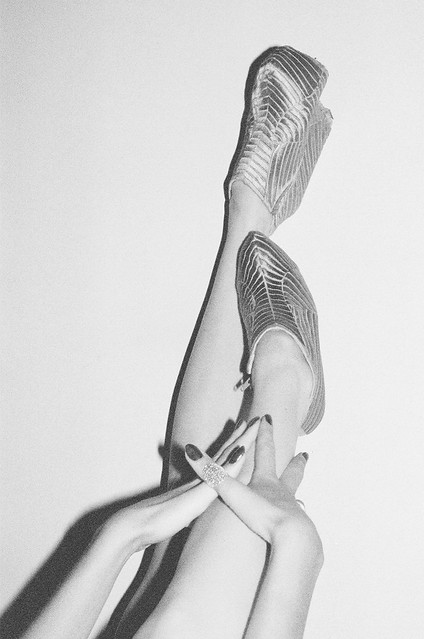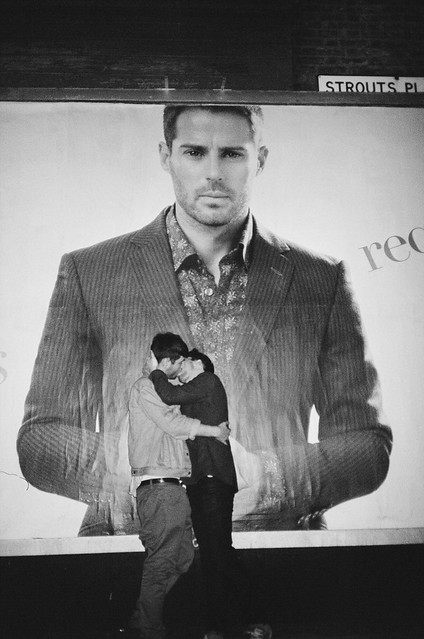Showing posts with label pop culture. Show all posts
Showing posts with label pop culture. Show all posts
July 7, 2011
June 23, 2011
In Conversation With David Zilber
David Chaim Jacob Zilber (b. 1985 in Toronto, Ontario) is a professional chef and butcher who has worked in fine dining establishments across Canada since 2004. Photography has been one of his chief creative outlets over the past 3 years, alongside cooking, painting, writing and industrial design. Working exclusively with 135 format film, his work has been disseminated around the world, featured in projects such as Street Carnage and City Arts Magazine. Currently living and working in Vancouver, British Columbia, Zilber is quickly becoming a prolific photographer in the contemporary art scene. As the creator of both the on-line photojournal Recidivism and Prolix, a book of his own black and white photographs, Zilber is slated to be published late 2011 in Montreal's Trapshot Archives.
Sam Milbrath: Hey how’s it going? Where are you right now?
David Zilber: Good, tired, just got through a 15 hour day in the kitchen. I’m at home now, on my white couch.
SJM: Shoot, what a long day. I am curious as to how much time you devote to photography every day. Do you merely go about the daily mundane with your camera at hand? Or do you prefer to shoot only when your feeling inspired?
DZ: I feel it sets you apart as a person, like, it defines you in a way, to be the type of person who never leaves the house without a camera (and I don’t mean a camera phone, I mean a proper camera). It says something about the way you think to always be ‘on’. Always ready to make a photograph should the need be there. Though I may carry my camera with me all the time, it doesn’t mean there’s always something to see… to document. A big part of how I shoot is through exploration. On my days off work, I’ll pick a location in the city to which I’ve never been, hop on my bike with a couple lenses and rolls in my bag, and go. Those are good days. I get inspired when I see something inspiring.
DZ: I like turning things on their head. I like taking objects out of context. Literally. I move a lot of the shit in my photos around in their immediate locus to mess up the order of things. Things you might overlook everyday, but framed in such a way that you can’t help but notice them in the photo, at the same time as being confused by why they’re there, because you can't reconcile any context… It harks back to the nature of the photograph itself. Solely a representational, acontextual, map of light. As for trends, I’m really into flora right now. And really deep d.o.f. I think I’m shooting the inanimate only because people don’t interest me anymore. They’re what’s left to pay attention to. I also don’t have that many friends out here yet, being new to the city.
SJM: Fair enough, I think we all oscillate between love of the inanimate and animate, often without finding proper balance. If you were to capture your ideal photograph, what would it look like content-wise?
DZ: A dead horse hanging from the ceiling. In a room wallpapered in brocade.
SJM: Wow, that’s quite the mental picture. It sounds like you’re leaning toward aesthetically pleasing, yet equally morbid photography. I like the evil playfulness. Let’s talk about your diptychs. What motivates you to collage certain photographs together? Are they matched based on colour or content coordination, or do they often express an idea, perhaps ironic, that you like to explore?
DZ: I love diptychs. It adds another layer of complexity to each of the chosen photos. I like that the correlations are not often clear. That what works about their pairings is their contrast and discord. Sometimes color palates dictate what goes with what. And sometimes content, but never obvious ideas. The ideas that I actually have in mind are far from being photographically relatable – Entropy, the scope of time, scientific determinism, and consciousness. My photos are the eisegetical result of some strange filter in my head that turns my environment into a translation of my mind. I believe art should never be overt. Subversion is key. I like to confuse my audience. Confusion through observation can have amusing qualities. You can enjoy incomprehension passively.
SJM: Interesting choice of words by stating that your work is an eisegetical result of your mind, because art is often completely misinterpreted and the original idea is lost, but that’s what makes it so beautifully subjective. Besides taking photographs of your surroundings, do you have any photography projects or shows on the go?
DZ: Ummmm, my friend Jack Allen is starting a small press this year out of Montreal – Trapshot Archives. It’s four books per ‘issue’. I’ll be the artist represented in this issue’s photography book. It’s strictly my old black and white stuff though. I know my style has changed since then, but they’re still great photos. Also, I make things out of my photos, just for myself – like my lightbox. But I’d love to do a gallery show. Maybe I’ll pursue it more seriously this year.
DZ: Here’s my current set-up. I don’t own a digital camera, apart from the one in my phone. I know it confuses a lot of people. I shoot with an 11 year old Canon Elan 7; I suppose it’s the film equivalent of today’s 7D. It looks like it should be a DSLR but it isn’t. It is just a really good, late model film camera. I have a bunch of other older manual cameras, but I don’t use them anymore.
SJM: I’m glad you shoot only film. I noticed that you shoot both black & white and colour, is there one that you like over the other when capturing certain moments?
DZ: I think that I’m done with black and white. I haven’t processed a roll of the stuff in months. I don’t know... I can say more with color. I shoot differently these days and just can’t get the message I want across in B&W.
SJM: Well your b&w photos are pretty amazing, but your artistic energy is definitely more apparent in colour. Anyway, your nighttime shots are pretty aesthetically raw from the full frontal, stark flashes. This technique reminds me of Dash Snow’s LES photographs of his friends passed out on dirty sidewalks with fuck the police attitudes. Do you agree that a lot of your work portrays the harsher realities of downtown Vancouver?
DZ: Mmmm, only out of necessity. I mean, I live in Chinatown, I’m in the downtown east side. Yeah, it can be rough, but I’m not documenting the roughness on purpose. I cannot photograph the surroundings that I’m not in. Only the ones I am.
SJM: Speaking of Dash Snow, which photographers have influenced your work the most? Do you see any similarities between your work and theirs?
DZ: Jermeie Ergy and Bruno Zhou. Their work is amazing. You get inside their heads by looking at their photographs. I strive to be that clever and direct… and impacting in my work. It takes talent though. It’s not easy. I have no desire to remake their photos; the similarity lies perhaps in the process. Oh, and my buddy Kavin Wong.
SJM: Your work is consistently direct… Along the same lines of influence, if you were to be curated into your personal ideal photography exhibition, which 5 other photographers would you want to be displayed with? Would there be a theme to the show?
DZ: Jeremie Ergy and Aurelien Arbet, Bruno Zhou, Nicolas Gottlund and David Brandon Geeting. Fuck themes.
SJM: Very cool. I’ll have to check those photographers out. I want to finish off with a fun question… So, if you could time travel to photograph any specific event, location, or era in history, where would you go and why? What kind of camera would you bring to shoot with?
DZ: I feel no attachment to the earth. If I could go anywhere, I’d try to photograph the first coalescence of matter in the universe. Where gravity pulled hydrogen ions out of the total soup. That’s asking a lot I guess. And as for the camera, any one that worked. The camera is secondary to the act. Someone once said that the best camera is the one you have on you. It’s so true.
SJM: Do you have anything else you want to say or advice for other aspiring photographers?
DZ: No, think I’m all good. As to other photographers, be original. And communicate something with your photography, it doesn’t need to be overtly pronounced, but it needs to be there somewhere. I mean, who really gives a shit about pictures of cats?
SJM: Great chatting with you David! Be sure to let me know of any of your shows in the future.
Images from photographer
Interview by Sam Milbrath of onwhitewalls
June 9, 2011
May 22, 2011
Aëla Labbé
I came across this French photographer a few days ago and have been tirelessly narrowing her work down ever since. I specifically chose these photographs because they portray a perfect balance between the eerie, magical, and wonderful. The children's flowing dresses and bare naked backs covered by long tangled hair, have an strange and fantastical, yet timeless effect on the audience. Her photographs are both current with popular aesthetic trends, but also cater to past imagery, making it difficult to gage the age of each photograph.
“To create and to share my vision is a need and a goal after which I go unwaveringly. Inspiration overwhelms me ceaselessly – day…and night! My work is made up of my memories, my emotions, my hopes, my thoughts, and my inner turbulences. There is a certain wistfulness about it – a shroud of reverie perhaps” - Aëla Labbé
Images from flickr.
May 20, 2011
May 18, 2011
April 19, 2011
Sylvain-Emmanuel Prieur
I could spend hours looking through Sylvain-Emmanuel's photographs. They are an aesthetically perfect match for my taste in photography. I actually painted a night sky with fireworks exploding across the canvas yesterday, that is based on this work.
I blogged last year about Prieur, but decided that it needed to be brought back into the limelight for the coming of summer, so here it is. Enjoy.
tryitillyoumakeit.com
February 25, 2011
David Richardson
Subscribe to:
Posts (Atom)
















































